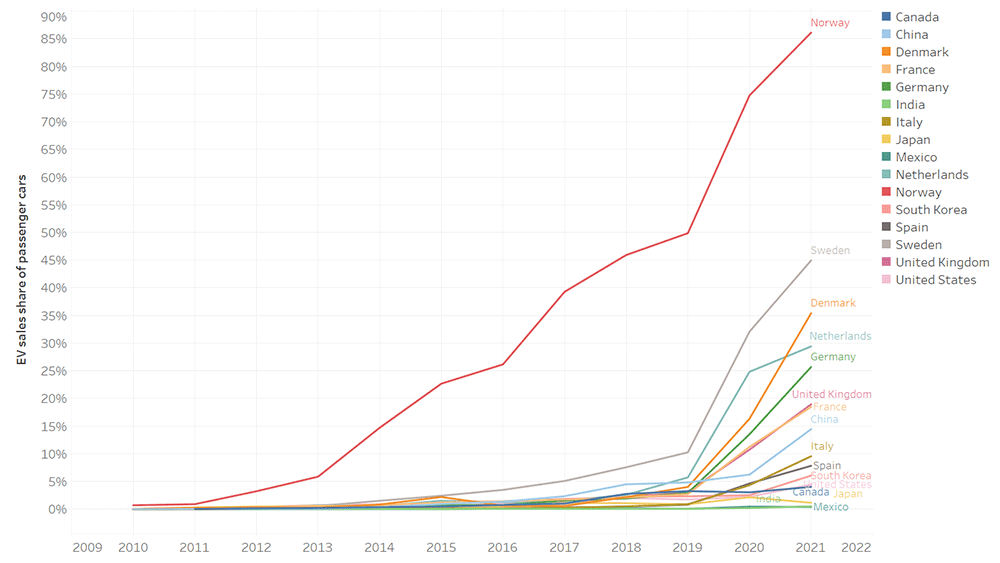Decarbonizing road transport by 2050: Zero-emission pathways for passenger vehicles
Blog
The G7 gets serious about decarbonizing road transportation
With everything else going on, you might have missed that the G7 ministers of climate, energy, and environment met in late May in Berlin and issued what is arguably the group’s strongest statement to date. The 39-page communiqué didn’t shy away from difficult questions. The ministers took strong stances on a range of topics bearing on “the multiple crises that are endangering our climate and environment and causing severe impacts on the planet, lives and livelihoods, and the next generations’ needs around the world,” from biodiversity to a circular economy, a just transition to supply chains, agriculture to chemical waste. This document signals the laws, regulations, and other measures that will be the focus for G7 members (Canada, France, Germany, Italy, Japan, the United Kingdom, and the United States) domestically as well as internationally. And while high-level documents like this on their own are not enough, they are essential to progress on decarbonizing transportation.
Naturally, we at the ICCT are most focused on what group had to say about transportation specifically. For a little background, here is what we know. Transportation is responsible for 25% of anthropogenic CO2 emissions globally, road transportation (cars, vans, trucks, and buses) is about 80% of that, and the G7 countries account for 40% of all road transportation emissions. To be in line with Paris climate targets the global on-road sector must reduce emissions from today by 45% by 2040, and 85% by 2050. The only viable technologies that can accomplish this level of reduction are ZEVs: specifically, battery electric vehicles (BEVs) powered by renewable electricity or fuel-cell electric vehicles (FCEVs) powered by green hydrogen. And of those BEVs are the more efficient by a wide margin, and therefore must be the primary technology for decarbonizing road transport. (Read much, much more on this in our extensive LCA ZEVTC publication and ICCT white papers). To accomplish GHG emissions reductions of sufficient magnitude, in the G7 member states 100% of cars and vans sold must be ZEVs by 2035 and 100% of buses and trucks sold must be ZEVs by 2040. Challenging but doable.
So how does the communiqué align with what our analysis shows is needed? Surprisingly well. They missed setting a deadline for ending sales of ICE cars and yet they agree to move in the right direction. Here are the two most highly relevant quotes (emphasis mine):
“We emphasise that keeping a limit of 1.5 °C temperature rise within reach is only possible through a swift and substantial reduction of greenhouse gas emissions from the transport sector by a massive uptake of electrification technology and deep cuts in emissions in the 2020s, facilitated by an overall transformation of the sector.”
“[W]e commit to a highly decarbonised road sector by 2030 including by, in this decade: significantly increasing the sale, share and uptake of zero emission light duty vehicles, including zero emission public transport and public vehicle fleets; accelerating the transition away from new sales of diesel and petrol cars; substantially reducing emissions from medium and heavy duty vehicles; investing significantly in charging and refueling infrastructure; promoting innovation; and supporting sustainable and safe battery recycling.”
Compare this to the statement released following the meeting of the same ministers just one year ago in May of 2021, in which electric vehicles were never explicitly mentioned let alone a group commitment to increase sales of ZEVs. The writing is on the wall. A group of some of the worlds largest and most influential governments has agreed to focus on the massive electrification of road transport as a key element in their response to the climate crisis.
Of course, as I already mentioned, we have to acknowledge that we didn’t get everything we might have wanted in this communiqué. What is missing is a date by which the sale of fossil fuel vehicles will be fully phased out. But a number of the G7 countries, as well as many other governments, are making this type of public commitment elsewhere, committing to 100% ZEV cars and vans by 2035 through the ZEV Declaration and 100% ZEV trucks and buses by 2040 through Drive to Zero’s Global MOU on Zero-Emission Medium- and Heavy-Duty Vehicles. In addition, the G7 members along with a number of other governments are collaborating through the ZEV Transition Council to accelerate the global transition to ZEVs.
So, all in all, a good outcome and another strong signal that the transition to a decarbonized transportation sector is underway.

Figure. Sales of electric vehicles are growing rapidly in recent years in a number of countries around the world.
